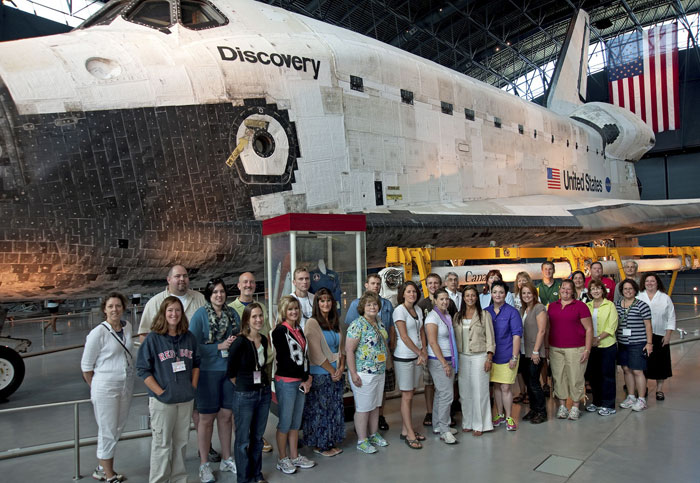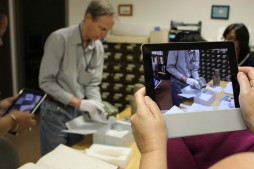Back to school

Participants in the 2012 “All Access Digital Arts Camp” at the Hirshhorn proudly display their certificates.
For most, summer is a time for slowing down and enjoying vacations with friends and family. For us, summer is our busy season, because many of those people on vacation are visiting the nation’s capital and New York City. This fiscal year we are on pace to welcome more than 30 million visitors for the first time this decade. Along with the big crowds visiting the museums, we also have a full slate of summer educational programs offered by our museums, the Smithsonian Associates, Smithsonian Center for Education and Museum Studies, and the Smithsonian National Science Resources Center. Although our commitment to educational programs during the summer months has been thriving for years, this year is exceptional. Smithsonian education is taking off with new programs, new digital delivery platforms and new facilities. As a lifelong educator, I could not be more pleased.
Programs
The Air and Space Museum’s Steven F. Udvar Hazy Center is already well known for its educational programs and our educators are finding even more creative ways to use the museum’s newest acquisition, Space Shuttle Discovery, to bring the wonder of human space exploration to students. Programs will feature Discovery in a “Learning Lab” focused on creative classwork, interactive activities and videos, and a 3/4-scale Discovery Flight Deck Simulator allowing learners of all ages to land the Space Shuttle themselves.
Back on the Mall, the American Indian Museum’s imagiNATIONS Activity Center, which opened this summer, offers the opportunity to learn by doing. Drop by and learn to build an iglu, test your knowledge about Native history, culture and customs in an interactive quiz show, participate in virtual skateboarding, and play a variety of tribal drums and other rhythm instruments.
Workshops
This summer, for the eighth straight year, the NSRC’s Professional Development Center offered professional development for science teachers during its Smithsonian Science Education Academies for Teachers. Focused on three areas—biodiversity, energy and Earth’s history and global change—this weeklong program of field trips and hands-on learning allowed teachers to go behind the scenes to get useful Smithsonian information to take back to their classrooms. In July, the 2012 NSRC Science Education Institute hosted interactive workshops to help educators develop strategic plans to build creative hands-on education programs for science education reform in the United States.
The Pearson Foundation funded a series of educational workshops, including EdLab workshops for local teachers and workshops based around core learning for some of the country’s outstanding educators. At the core learning workshop, one Arizona math teacher shared how she is working with her local forest service to understand how bark beetles may increase the risk of forest fires. Her class connected not only with our bark beetle expert at the Natural History Museum but also with the Air and Space Museum to see how infrared satellite imaging can be used to fight forest fires by detecting hotspots and movement patterns.
The Pearson Foundation also sponsored workshops for teens at the Hirshhorn’s ArtLab+, including the second annual “All Access Digital Arts Camp,” created in partnership with the New Learning Institute, the SCEMS and the Smithsonian Accessibility Program. It allowed students with intellectual and cognitive disabilities to create and share their multimedia artwork, while building vital skills and confidence. As a parent of a previous participant noted, “There are no barriers because it’s so visual and hands-on— everyone gets something out of it.” I could not be prouder that the Smithsonian is removing educational barriers and expanding opportunity for young people who may have been previously marginalized.
Technology
The Encyclopedia of Life was founded in 2007 by the Smithsonian and four other cornerstone organizations to compile information on each of the planet’s 1.9 million recognized species. Intended to be a resource for scientists and lay people alike, it is also an amazing resource for teachers and students through a terrific new EOL website. The site’s rich content includes podcasts and printable field guides to identify species in the wild. It also affords thousands of students and parents the chance to become citizen-scientists in their own hometowns by participating in biological scavenger hunts called BioBlitzes that fan out over large areas to catalog different species of wildlife. They can then post their findings online, adding to the Encyclopedia of Life’s species database.
Claudine Brown and Smithsonian Educational Technology Specialist Peter Haydock are working with NSRC and Smithsonian Affiliations to develop a customizable suite of online tools called “My SI” that will allow researchers and educators Institution-wide to collect scientific information and share it. Not only will My SI enable us to collect scientific data about water quality, flora, and fauna, but also allow us to carry out citizen and student engagement, collecting stories and multimedia to engage audiences and inspire citizen scientists. We hope to have the first set of these tools available at the beginning of the year.
What’s Next
We’ve had an active and productive summer—both in terms of what we have done and in respect to the preparations for what is to come—and I thank you for all your hard work. Since James Smithson exhorted the United States to create an Institution to increase and diffuse knowledge, our core mission has not wavered. And though the tools to accomplish that goal have changed, the experts, collections and abilities of the Smithsonian remain unmatched. As one of our “All Access” Digital Campers replied when asked if the camp could happen somewhere other than the Smithsonian, “They wouldn’t have the awesome, cool stuff.” To that I would add that nowhere else would have our passionate people. Judging by the amazing wellspring of creativity you have fostered in the educational programs we are developing and implementing, it is clear that the future of education is already here.

Participants in a 2012 NSRC Science Education Institute workshop at the Air and Space Museum’s Udvar Hazy Center. (Photo by Mark Avino)
Posted: 31 August 2012
-
Categories:
Collaboration , Education, Access & Outreach , From the Secretary






I found the synopsis of educational activities interesting, and was not aware of the EOL program until this artical.
Jay Missal
TSA Volunteer